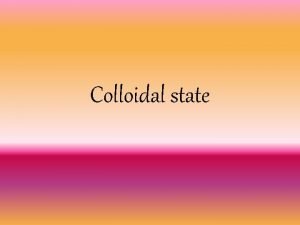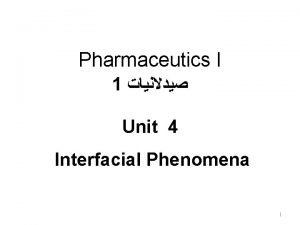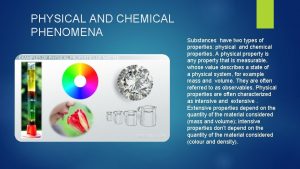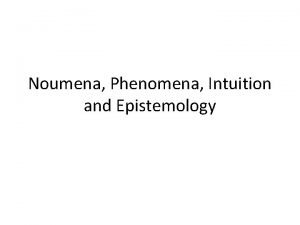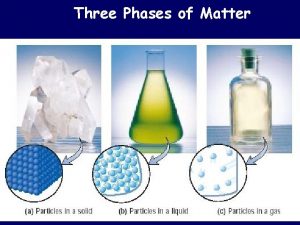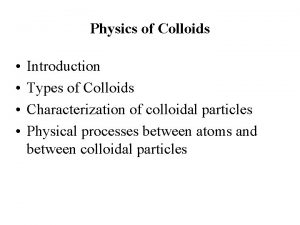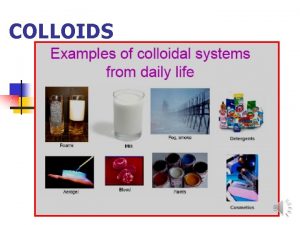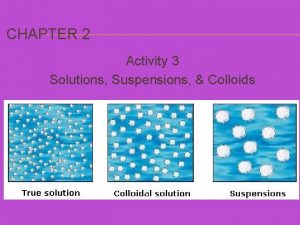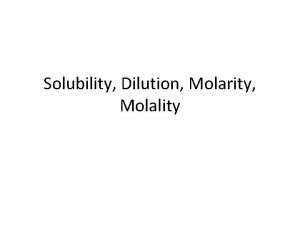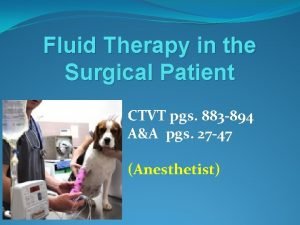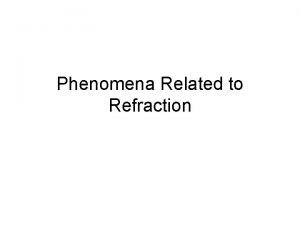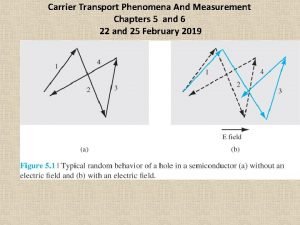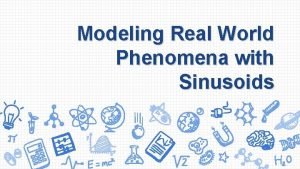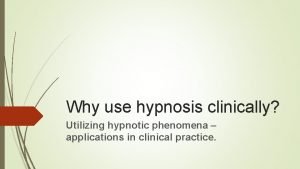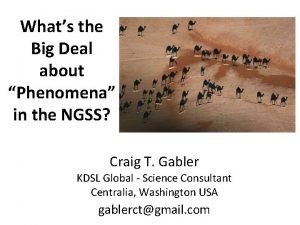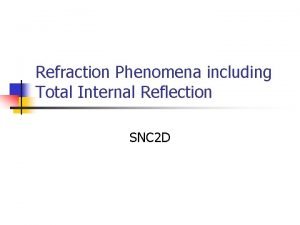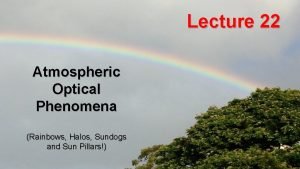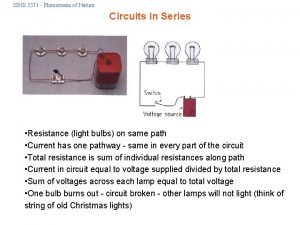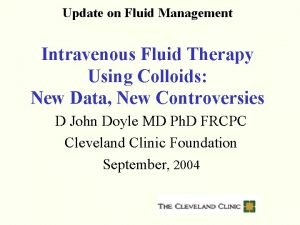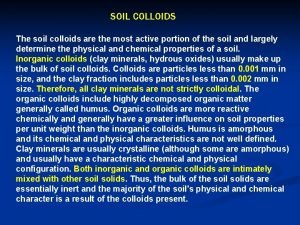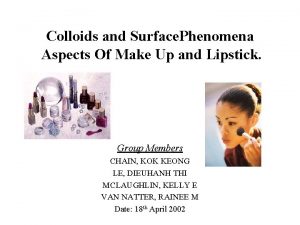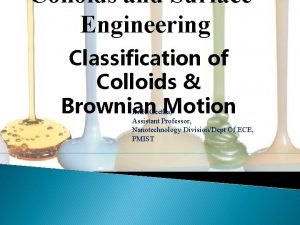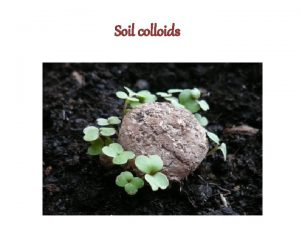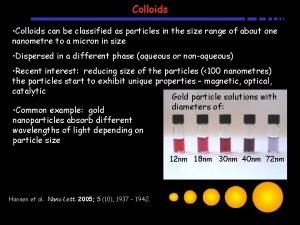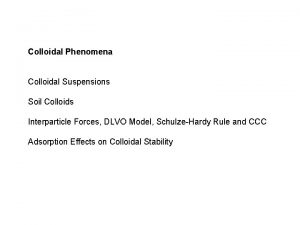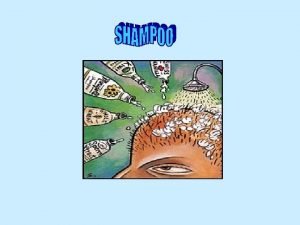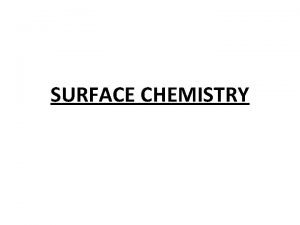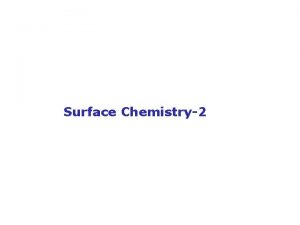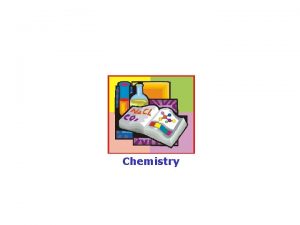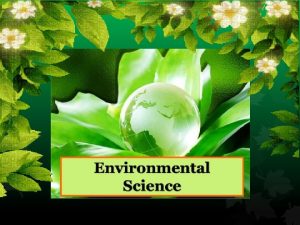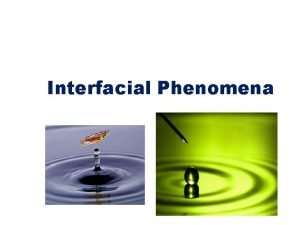Colloids and Surface Phenomena Aspects Of Make Up








































- Slides: 40

Colloids and Surface. Phenomena Aspects Of Make Up and Lipstick. Group Members CHAIN, KOK KEONG LE, DIEUHANH THI MCLAUGHLIN, KELLY E VAN NATTER, RAINEE M Date: 18 th April 2002

Introduction • • Definition of Cosmetic Ingredients Overview of Customer Requirements Role by Polymer and Surfactants Application in Cosmetic Products: – Eye shadow and Blush – Lipstick – Liquid Cream – Pressed Powder for both pale and dark skin

Overview of Cosmetic • Consumer aspect – High quality – Safe or non allergic – Reasonable Price – Multiple Performance – Long Wearing

Role by Polymer And Surfactant • Polymer – gel like, long chain carbon with cross-linked conformation • Encapsulation • Firm distribution • High internal surface areas, ideal sorption and desorption mechanism • Surfactant – hydrophilic head group + hydrophobic tail • Emollients, wetting agents, and emulsifying agents, humectants • To promote lubricant, adhesiveness, slip and covering purposes

What are pressed powder properties? • Slip – Spread Easily, smooth feeling – Rhapsody, Zinc Stearate • Adhesiveness – Cling Together – Zinc Stearate, Octyl Palmitate • Other Ingredients – Coloring Pigments, Iron Oxide – Shininess Appearance – Not over darkness and chalkiness

Pressed Powder for both pale and dark skin

Action and Mechanism • Zinc Stearate – Zn (C 18 H 35 O 2)2, – long hydrocarbon chain – ideal physicals • < 6% of moisture, alkaline, soluble in mineral oils – promoting the powder flow ability – reduced the interfacial tension • Octyl Palmitate – as liquid binder, – provide cohesion – as emulsifier, emollients • Iron Oxide – (Fe 2 O 3) , Color Pigment

How to Produce make up? • Guidelines by Ultra. Chemical Inc. – pulverize or to crush Rhapsody talc in to powder form – compress them into pan utilizing (200 psi – 2000 psi )

Lipsticks • Purpose: – Protect lips from hard weather – Color lips • Objectives: – Variation in color from application to application – Lasts all day – Removable with cleansers • Basic categories of lipsticks: – – – Matte: heavy in wax and pigment but lighter in emollients. Gloss: less wax and more oil to make the lips shinier. Long lasting: contains silicone oil, which seals the color the lips. Satin: combination of gloss and matte lipsticks. Frosted: include a pearl zing agent that adds luster to the color.

Lipsticks • Example of Lipsticks, Matte • Formulation composition* Components Range % by wt 1. Candellela Wax 3. 0 -9. 0 2. Ozokerite 1. 0 -4. 0 3. Paraffin wax 2. 0 -5. 0 4. Isosteryl Isostearated 2. 0 -10. 0 5. Ultrapure HMP-S 8. 0 -10. 0 6. Capric/Caprylic Triglyceride 2. 0 -10. 0 7. Castor Oil QS 8. Propyl Paraben 0. 10 9. Tocopheryl Acetate 0. 1 -1. 0 10. Colorants: D&C #7 CA lake 0. 0 -4. 0 11. Red Oxide 0. 0 -3. 0 12. Rhapsody Talc 4 M 2. 0 -10. 0 *Ultra Chemical Inc. Preferred by wt 3. 0 1. 0 2. 0 10. 0 51. 6 0. 10 0. 30 1. 5 10. 0 Total 100. 0

Lipsticks • Function of Ingredients 1. Emollients a. Castor oil: -extracted from castor plant b. Capric/Caprylic Triglyceride: -oily liquid extract from plant vegetable oil and dairy fats. 2. 3. c. Isostearyl Isostearate Emulsifiers a. Paraffin Wax: -derived from petroleum b. Ozokerite Wax: -ceresin wax, naturally occurs in mineral wax. Preservatives a. Propyl Parahen: -propyl-4 -hydroxylbenzoate and prepare from pbromophenol 4. 5. Colorants a. D&C Red #7 CA lake: b. Red Oxide c. Ultrapure HMP-S Binders a. Candellia wax

Lipsticks • Processing 1. Heat the ingredients to 75 -85 degree Celsius 2. Mix until the batch is smooth and uniform

Lipstick Shapes, packaging and price *There are different shapes and packaging of lipsticks. The prices are ranging from $1. 99 to $29. 99, depending to the Brand name of product, such as Lancôme , Avon, L’Oreal, etc.

~40 sec Eyeshadow & Rouge • Purpose: – To provide color • Requirements & Objectives: – – Contain pigments Adhere to skin Have adequate “slip” to spread onto skin Limited solubility in perspiration (to avoid streaking), but easily removable with cleansers – Safe for eyes (preservatives)

~25 sec Forms Solid, creamy Dry, Compact Liquid suspension/ emulsion (Black Opal/Bio. Cosmetic Research Labs) Solid, stick (Almay, Inc. ) (L’Oreal) (Wet N Wild)

(Brief Overview Slide) Rouge/Eyeshadow Ingredients • • • Filler Pigments and Opacifiers Binders Emulsifiers Emollients Preservatives Absorbents Perfume Carriers Viscosity controllers/thickeners

Talc already discussed (kkc) don’t describe in detail Below: esters and oils Main Ingredients • Dry, Compact Cosmetics: – Talc (3 Mg. O· 4 Si. O 2·H 2 O) (Filler) – – “Slip” and shine due to lamellar structure Very soft White Adheres to skin evenly • Liquid/Gel Rouges: – Water (Solvent) • Cream/Solid Cosmetics: – – Caprylic/capric triglyceride (Solvent & Emollient) Octyl Palmitate (Binder & Emollient) Mineral Oil (Binder) Castor Oil (see “Lipsticks”) (Marmion, Sagarin 223 -224)

~15 sec Pigments & Opacifiers • Purpose: – To provide the color for the cosmetic – Opacifiers increase the opaqueness (coverage) of the applied cosmetic color • Objectives: – Should not change color, bleed, or streak with p. H changes, water, or oil (perspiration) – Should not fade significantly when exposed to light – Be heat stable – Be easy to add into product – Be non-toxic – All pigments of same particle size (Sagarin 229 -235, Poucher III 283)

5 sec- refer them to web site Common Inorganic Pigments Pigment Structure Color(s) Talc Mg. O· 4 Si. O 2·H 2 O White (Filler, Opacifier) Zinc Oxide Zn. O White/yellowish white (Opacifier) Titanium dioxide Ti. O 2 White (Opacifier) Mica K 2 Al 4(Al 2 Si 6 O 20)(OH 4) or H 2 KAl 3(Si. O 4)3 White, pearlescence Carbon black C(s) Black Iron Oxides Fe 3 O 4 Black Iron Oxides, ochres, umbers Fe 2 O 3 Red, brown Iron Oxides, Yellow ochres Fe 2 O 3·H 2 O Yellow-orange Siennas Yellow, Brown Ultramarines ~Na 7 Al 6 Si 6 O 24 S 3 Blues, violets, greens, pinks, reds Chromium oxides, hydroxide Cr 2 O 3, Cr 2 O 3· 3 H 2 O Yellowish (sage) green, bluish green Aluminum powder Al (s) Silver Ferric Ferro-Cyanide, ferric ammonium ferrocyanide Fe 4[Fe(CN)6]3 XH 2 O, Prussian blue Manganese Violet ~Mn 3+NH 4 P 2 O 7 violet Bismuth Oxychloride Bi. OCl Pearly lustre (Marmion 99 -111, Sagarin 228, 233, PCI, Jones)

Binders, Emulsifying Agents, Surfactants, and Emollients • Binders: – Provide cohesion of powders • Emulsifying Agents/Surfactants – Promote the mixing of otherwise immiscible liquids – Lower surface tension, promoting more even mixing • Emollients – Soften and smooth the skin • ***Many cosmetic ingredients serve more than 1 of these purposes, and thus they have been combined for the purpose of listing ingredients. (“European Commission”, Sagarin 257)

Only discuss those found in sample formulation that I pick Common Binders, Emulsifying Agents, Surfactants, and Emollients • • Zinc and Magnesium Stearate (dry binder) Caprylic/capric triglyceride (solvent/emollient) Octyl Palmitate (binder/emollient) Mineral Oil (binder/emollient) Petroletum (binder/emollient) Squalane (liquid binder/emollient) Isopropyl myristate (liquid binder) Waxes (binders/emulsion stabilizers/emollients/viscosity controlling agents) • Castor Oil (see “lipsticks”) (“European Commission”, Sagarin 227, 256 -258, 288, 390, Poucher I 50, 344)

Preservatives & Absorbents • • • Preservatives – Purpose • Inhibit the growth of micro-organisms – Examples • Parabens (esters of p-hydroxybenzoic acid) • Glyceryl Monolaurate • EDTA • Imidazolidinyl Urea Absorbents: – Purpose: Absorb water/oil. – Examples: Magnesium carbonate, Kaolin Perfume Carriers: – Examples: Magnesium carbonate, Chalk Paraben (p-hydroxybenzoate) (“Product Dictionary”), (European Commission)

Compact Powder Eyeshadow (Compact Powder Rouge is manufactured similarly) (Almay, Inc. ) Talc (Filler) 64. 7%(wt) Ultramarine Blue (Pigment) 64. 7% 20. 0% Filler Octyl Palmitate (Liquid Binder) 7. 0% Pigment 22. 6% Squalane (Liquid Binder) 3. 5% Liquid Binder 10. 5% Iron Oxides (Pigment) 2. 6% Solid Binder Zinc Stearate (Solid Binder) 2. 0% Glyceryl Monolaurate Preservatives 0. 6% (monoglyceride) (Preservative) 0. 5% EDTA (Preservative) 0. 1% (Ultra Chem) (Almay, Inc. ) Procedure: 1. Mill, grind, mix dry powder ingredients 2. Spray liquid phase into powder while mixing 3. Distribute 4. Press 5. Dry (Ultra Chem), (Sagarin 258 -261)

Liquid/Gel Rouge (L’Oreal) Procedure: 1. 2. 3. 4. 5. 6. Water (softened or distilled) Glycerin (solvent) Diethylene glycol monostearate (emulsifier) Water 67% Cetyl alcohol ethoxylate Other Solvents 19% Titanium dioxide Pigment 4. 5% Pigment Emulsifiers 9. 6% Iso-Propyl myristate (binder) Perfumes 0. 2% Cetyl alcohol Preservatives 0. 15% (emulsifier/emollient) Perfume Methyl paraben (preservative) Bromo acid (colourant) 67% 19% 4. 3% 2. 9% 2 -3% 2. 0% 1. 9% 0. 48% 0. 2% 0. 15% 0. 02% Heat and mix emulsion base. Dissolve methylparaben in glycerin by heat (separate vessel). Add water to glycerin and heat to 75°C. Add water-glycerin mixture to emulsion base with slow, continuous stirring. Allow to cool with continuous stirring. Add perfume and pigment, including titanium dioxide, to mixture and mix well. (Poucher III 284)

Solid (stick) Rouge (Wet N Wild) Castor Oil Candelilla wax Carnauba wax Color Perfume 77. 4% 9. 9% 2. 7% 10. 0% q. s. (Processed similar to lipstick) (Sagarin 254)

Cream-Solid Eyeshadow (Black Opal/ Bio. Cosmetic Research Labs) Petroleum jelly* (binder/base) 25. 6% Paraffin wax (binder/emollient) 22. 6% Isopropyl palmitate (binder/emollient)16. 4% Binders/Emollients/ 10. 3% Lustre Pigments Emulsifiers 8. 2%82. 0% Beeswax (binder/emollient) 5. 1% Pigment 18. 5% Oleyl alcohol (emulsion stab. ) 5. 1% Perfumes Lanolin (emollient) 4. 1%0. 5% Preservatives 0. 03% Cetyl alcohol (emulsifier/emollient)3. 1% Perfume 0. 5% Butylparaben (preservative) 0. 02% Propylparaben (preservative) 0. 01% Procedure: • Heat together non-wax binders/emulsifiers/emollients • Mix in preservatives and pigments • Melt waxes and add with lustre pigments to base mixture • Cool, and add perfume • Pour into moulds and allow to set (Poucher III 294)

Mascara (Almay) Isoparaffin (Solvent) Pigments Beeswax Solvent Ozokerite wax Waxes Polyethylene Pigments Carnauba wax Polyethylene Microcrystalline wax 69. 7% 12. 0% 5. 4% 69. 7% 5. 4% 14. 0% 4. 2% 12. 0% 4. 2% 1. 2% Procedure: 1. Mix polyethylene with about half the solvent 2. Heat to about 100°C with stirring 3. Add remainder of solvent 4. Cool rapidly 5. Add the pigments and melted waxes, and mixed thoroughly. (Poucher III 305)

Properties of Liquid Cream • • Cover blemishes in skin Even skin tone and texture Does not rub off Removable with cleansers

Liquid Cream Composition

Function of Ingredients • Humectants – Reduce drying out of cream – Moisturize skin – Plasticize product – Control texture • Emulsifiers – Create stable mixture of oil and water

Function of Ingredients • Emollients – Smooth skin – Soften skin • Gums – Protective colloid – Suspending agent – Film formation

Function of Ingredients • Vehicle – Deionized water • Filler/Matrix – Talc, Rhapsody 4 M • Colorants – Add color – Iron oxides and titanium dioxide

Function of Ingredients • Fragrances • Preservatives

Processing • Add deionized water to kettle and water phase ingredients • Disperse gums and pigments • Heat to 75 deg C • Combine oil phase ingredients separately • Heat to 70 deg C

Processing • • Add oil phase to water phase Cool to 35 deg C Add fragrance and preservatives Cool to 28 deg C

Product -> Market -> Consumer • Marketing Techniques – Advertisement • Visual, internet • Odor, magazine – Free Sample – Counseling • Product advice – Consumer research • questionnaires – Efficiency

Cosmetics Labeling • Manufactures of cosmetics must print certain information on the labels of each product: – The identity of the product – The net quantity in metric units – The name and address of the manufacturer or distributor – Any warnings or cautions necessary for the safe use of the product.

Labeling • Types of labels – White labels – Clear labels – Labels on the bottles

Conclusion • Characteristics of Polymer and Surfactant – – • Eye shadow and Blush – • Color; Waxes and vegetable oils as emulsifiers Liquid Cream – • Color; binders (dry compact), emulsifiers (gel/cream) Lipstick – • Suspension of cosmetic ingredients Favorable adhere to skin Emulsifiers, preservatives Face Powder – Reduce interfacial tension, adhere, slip

References Andersen, Kristin. “Cosmetic Colorants. ” Healthwell. Penton Media (04 Apr 2002). http: //www. healthwell. com/hnbreakthroughs/apr 98/colorants. cfm. European Commission Enterprise DG UNIT F/3 - Biotechnology, Competitiveness in Pharmaceuticals, Cosmetics. “The International Nomenclature of Cosmetic Ingredients. ” (23 Oct 2001). http: //eudrams 1. is. eudra. org/F 3/home. html - Inventory of Cosmetic Ingredients Jones, Mr. “Photographic Chemical Descriptions. ” (23 Mar 2001). http: //www. speakeasy. org/~mrjones/chemdesc. htm - photographic chemical site, used to get pigment color of ferric ferrocyanide Marmion, Daniel M. Handbook of U. S. Colorants for Food, Drugs, and Cosmetics. 2 nd Ed. John Wiley & Sons (1984). Paint and Coatings Industry (PCI). (Iron Oxide Information) http: //www. pcimag. com/CDA/Article. Information/features/BNP_Features_Item/0, 1846, 13449, 00. html. Poucher, W. A. , and G. M. Howard. Perfumes, Cosmetics and Soaps. Vol. I. 8 th Ed. Chapman and Hall (1974). Poucher, W. A. , and G. M. Howard. Perfumes, Cosmetics and Soaps. Vol. III. 8 th Ed. Chapman and Hall (1974). “Product Dictionary. ” Make Me Up (2000). http: //www. emakemeup. com/ingredients. html - List and short description of cosmetic ingredients Sagarin, Edward, Ed. Cosmetics: Science and Technology. Interscience Publishers (1957). Ultra Chemical Inc. “Pressed Eyeshadow, Matte. ” (2000). http: //www. ultrachem. com/formulations/pressedeyeshadow. html. Walgreens. http: //www. walgreens. com. - Cosmetics photos.
 Lyophilic colloids and lyophobic colloids difference
Lyophilic colloids and lyophobic colloids difference Colloidal meaning
Colloidal meaning Colloids examples
Colloids examples Surface and interfacial phenomena
Surface and interfacial phenomena Physical and chemical phenomena
Physical and chemical phenomena Noumenon
Noumenon Types of colloids and examples
Types of colloids and examples Colloids table
Colloids table Colloids fluids examples
Colloids fluids examples Difference between colloids and crystalloids
Difference between colloids and crystalloids Crystalloid fluids examples
Crystalloid fluids examples Tyndall effect is an optical property
Tyndall effect is an optical property Solutions, suspensions and colloids activity
Solutions, suspensions and colloids activity Solubility curve
Solubility curve Colloid solutions
Colloid solutions Volume and surface area of cone
Volume and surface area of cone Is lateral area the same as surface area
Is lateral area the same as surface area Phenomena yksikkö
Phenomena yksikkö Some natural phenomena class 8 ppt
Some natural phenomena class 8 ppt Phenomena related to refraction of light
Phenomena related to refraction of light Observable phenomena psychology
Observable phenomena psychology Objective consideration of contemporary phenomena
Objective consideration of contemporary phenomena Reference phenomenon in nlp
Reference phenomenon in nlp Reference phenomena in nlp
Reference phenomena in nlp Is gravity a natural phenomenon
Is gravity a natural phenomenon Carrier transport phenomena
Carrier transport phenomena Anchor phenomena
Anchor phenomena Observable phenomena
Observable phenomena Reoulox phenomena
Reoulox phenomena Global climate phenomena
Global climate phenomena Random phenomena
Random phenomena Modeling with sinusoidal functions
Modeling with sinusoidal functions Brigitte falkenburg
Brigitte falkenburg Slidetodoc download
Slidetodoc download Noumena vs phenomena
Noumena vs phenomena Noumena vs phenomena
Noumena vs phenomena What is critical angle
What is critical angle Optical phenomena rainbow
Optical phenomena rainbow Noumena vs phenomena
Noumena vs phenomena Colloids fluids examples
Colloids fluids examples What is soil colloids
What is soil colloids

